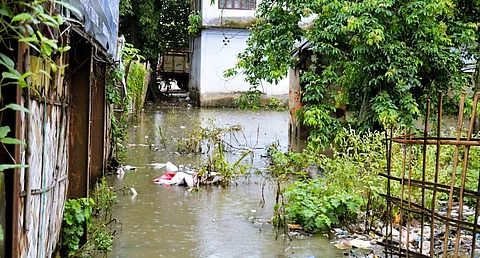
- Home
- Live Blog
- Breaking News
- Top Headlines
- Cities
- NE News
- Sentinel Media
- Sports
- Education
- Jobs

OUR CORRESPONDENT
TEZPUR: Tezpur, often hailed as the Cultural Capital of Assam and once celebrated as the cleanest city in the region, is currently grappling with an unprecedented urban crisis. Once renowned for its scenic beauty and lush greenery, the city now finds itself submerged in severe waterlogging, affecting multiple wards and exposing glaring civic negligence.
Incessant rainfall has led to widespread inundation across several areas, including Ward 10 (opposite IMA House), O-Point, Ward 19 (Chanmari, Jyotibon area), Ward 18 (Rail Gate), and Ward 16. Residents are reeling under immense hardship as their homes and roads remain submerged, with daily life brought to a standstill. What was once a vibrant city is now a swampy mess, raising serious questions about the preparedness and efficiency of the Tezpur Municipal Board.
One of the major contributors to this artificial flooding is the rampant encroachment on natural wetlands and unregulated construction activity. Illegal structures have mushroomed in flood-prone areas such as Kekurapul, Hatipilkhana, the east of Subarnarekha Road, southern parts near Darrang College, Mazgaon, and near the District Malaria Office. These developments have severely disrupted the town’s natural drainage systems.
Despite repeated incidents of flooding year after year, the municipal board has failed to implement any long-term solutions. Drains remain clogged, infrastructure is crumbling, and civic services are virtually non-functional. In areas like the Anant Complex, near the Tezpur Main Post Office-Mahabhairav Temple road, residents continue to suffer as water accumulates due to choked drainage lines.
The Tezpur Municipal Board, established in 1894 and responsible for an area of 7.10 sq km, is governed by a council of 19 elected ward commissioners. However, its record of civic service remains abysmal. Official data from the 2011 census indicates a population of 58,559 within municipal limits, including over 6,600 slum dwellers and 13,749 households. The board is tasked with providing basic amenities such as water supply, sanitation, garbage disposal, street lighting, and road maintenance—but it has failed on nearly all fronts.
While 43.9 km of roads and 112.95 km of drainage were reportedly constructed in recent years, these efforts have clearly fallen short. Community infrastructure, including seven markets, 33 halls, five heritage ponds, and one public burial ground, remains in poor condition due to administrative neglect.
Social worker Swarup Mohan Das, a resident of Ward 10, confirmed that a formal representation was submitted to the board regarding the waterlogging crisis. “It is disheartening to see no action taken. If this is the state of central Tezpur, one can only imagine the suffering in the outskirts,” he said.
Also Watch: